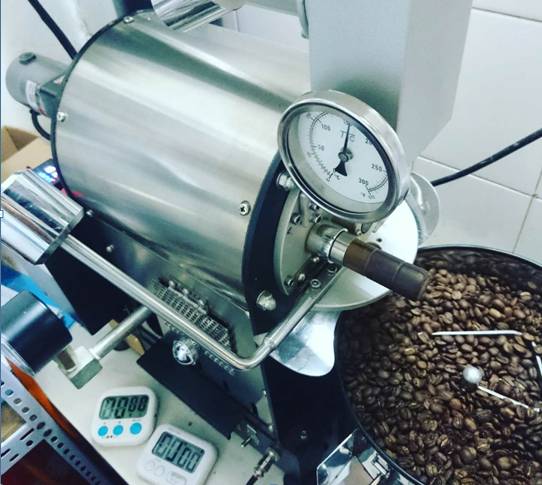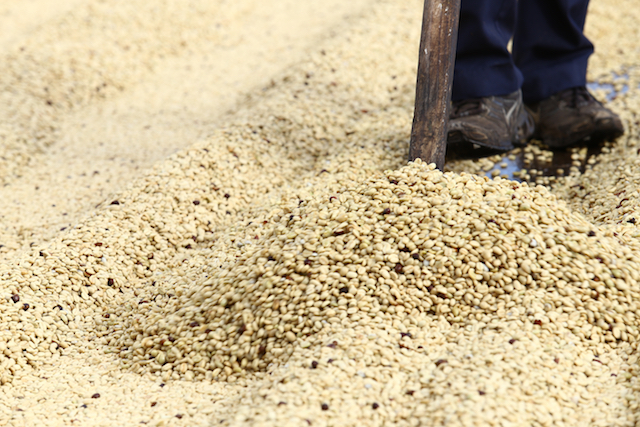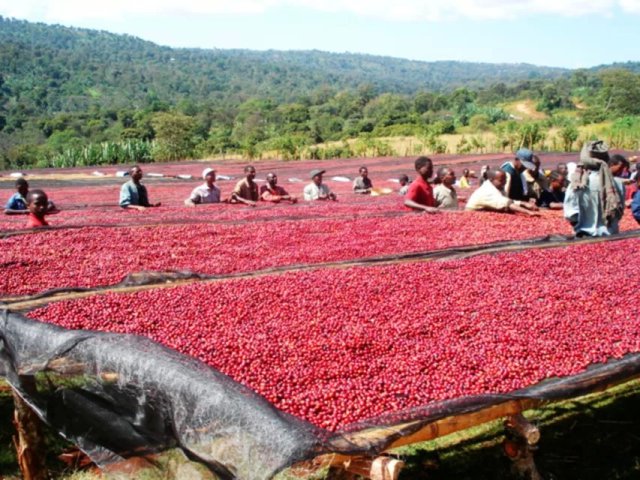Professional coffee roasting | relationship between raw beans and roasting

For professional baristas, please follow the coffee workshop (Wechat official account cafe_style)
Although it is often said that "hard beans are difficult to bake", "this kind of coffee beans are easy to bake" and so on, the most important thing in determining the research approach to roasting is to understand the differences in the state and characteristics of raw beans. There is no doubt that each kind of coffee bean has its most suitable baking method, but there is also a certain degree of regularity between the characteristics of raw beans and roasting, so let's introduce the items that can be used as a basis for judgment.
1
The size and thickness of raw beans
When using the same firepower and exhaust for the same baking operation, compared with small beans, large beans are certainly not easily heated. Since it is not easy to heat, if there is not enough firepower, the coffee beans are easy to be undercooked and may end up being reduced to a bad cup of coffee. Based on this, it is generally said that large coffee beans are difficult to bake. Similarly, compared with raw beans with thin flesh, raw beans with thick flesh will be difficult to be heated and easy to be half-cooked. In addition, even for large coffee beans, the thin flesh is more likely to be heated; even for small coffee beans, the flesh is thick and difficult to bake.

Therefore, once the raw beans of different sizes are put into the pot at the same time during baking, the heating will vary with the size of the beans. Therefore, in order to prevent the occurrence of flower beans, the granules of raw beans will be kept consistent in size to reduce the chance of baking failure.
1
Origin elevation
The coffee beans that take time to grow slowly generally tend to be hard and small in the highlands with high and low temperatures. This kind of coffee beans, which are cultivated in a severe environment, are mostly rich in flavor and aroma. Although there are exceptions, coffee beans from high producing areas are more precious than those from low producing areas, and the vast majority of cases are sold at high prices. In terms of baking, because hard beans suffer more heat than soft beans, and water evaporation is also poor, once there are not enough calories in baking, it is easy to be undercooked. In addition, the surface of coffee beans is wrinkled after the first explosion, and hard beans are more difficult to stretch than soft beans.

1
Moisture content
Generally speaking, raw beans with more water content will show a dense green color, while raw beans with less water content will show brown or white color (there will be exceptions depending on the origin). The amount of water content will not only be different because of the cultivation and refining methods of the producing area, but also affected by the preservation status, but it will generally decrease gradually with the passage of time. However, the way in which each kind of coffee bean evaporates water is very different and cannot be calculated simply by the number of days after harvest.

In the aspect of baking, coffee beans with more water content will be difficult to be heated, and it is easy to be half-cooked and half-cooked, which makes it more difficult to bake. Therefore, it is necessary to let the water contained in coffee beans evaporate smoothly during baking.
one
Newly harvested Coffee beans and seasonal changes
The coffee beans harvested this year are called newly harvested coffee beans (New Crop). The newly harvested beans purchased are basically tender in appearance and high in moisture content, and the flavor and sour taste of coffee beans are also very obvious. But with the passage of time, the moisture content will gradually decrease, and the color will gradually whiten. With the decrease of water content, coffee beans will gradually lose their aroma and sour taste, so it is necessary to adjust the roasting methods according to the changes of coffee beans.

one
The attachment of silver skin
The thin skin covered by the surface of raw beans is called silver. Raw beans with silver skins are generally regarded as high quality and brown raw beans as inferior (except those treated by Brazilian semi-washing or polishing).

In the baking operation, the silver skin will be preferentially heated and peeled off from the raw beans. And peeled off the silver skin, along with the baking, leading to fire and other hazards, so the metropolis will control the exhaust valve to discharge. The amount of silver skin will be greatly affected by the refining method. In the case of washing, the silver skin will mostly be removed, while in the case of natural drying, the silver skin will mostly remain until after shelling. In addition, when water-washed coffee beans are lightly roasted, white silver skins remain in the central line, while in dried coffee beans, the silver skins in the central line tend to become scorched black. If there is too much silver left after baking, it will lead to the bitter taste of the coffee, so it will be cleared as clean as possible.
one
Refining method (treatment method)
The refining methods of coffee beans are roughly divided into three types, namely, natural drying type, water washing type and semi-washing type. Different refining methods, aroma and sour taste presentation methods are also different, which will have a great impact on the taste of coffee.
Popular science | how coffee is made, a summary of several common ways to treat raw coffee and beans

one
Defective bean
Under the rising awareness of boutique coffee, the overall quality of coffee beans is also improved than in the past, but also reduce the amount of defective beans mixed with boutique coffee. But even if only mixed in, it will still greatly damage the taste of coffee and customer trust, so in order to provide higher quality coffee, hand-selected homework can be said to be imperative.
The removal of defective beans and foreign bodies is the purpose of manual selection, but defective beans are also divided into types that are difficult to find after baking and types that are easier to find after baking. Therefore, it is best to carry out the manual selection once after confirming the status of the raw beans and after the baking is finished. It is difficult to distinguish between unripe beans and fermented beans after baking, so be sure to confirm the status before baking and get rid of any abnormal coffee beans.

The main types of defective beans are as follows:
To show you the world of defective coffee beans.
MEMO
The evolution of transportation and packaging
The method of transporting and packing raw beans from the origin has also changed with the appearance of boutique coffee. For example, when transporting raw beans, high temperature and drastic temperature changes can cause damage to raw beans. Therefore, when transporting boutique coffee, more and more cases are using refrigerated containers that can be kept at a constant temperature.
In addition, it has been common sense for many years to pack raw beans in gunny bags, but with the advent of small vacuum bags, as well as heat-resistant, moisture-resistant plastic bags for grains (commonly known as "grain bags") that can isolate air and moisture, it is expected to improve the effect of ensuring the freshness of raw beans.
How to grasp the state of raw beans?
There are many experts on coffee beans who only need to touch them with their hands to know the state and characteristics of the raw beans. After all, they pick or grab coffee beans with their hands every day, so they can tell the difference between coffee beans by feeling. In terms of distance, if you grab a handful of coffee beans with the same number as usual, you will feel lighter in weight, you can judge that the proportion of this coffee bean relative to volume is small. In addition, raw beans that feel cold and cool during a light grip indicate that they have a high water content, and experts can even use it to judge that the raw beans are likely to be newly harvested coffee beans.
This article excerpts "High quality Baking Technology of famous Coffee shops in Japan"
Important Notice :
前街咖啡 FrontStreet Coffee has moved to new addredd:
FrontStreet Coffee Address: 315,Donghua East Road,GuangZhou
Tel:020 38364473
- Prev

The coffee from the espresso machine is not good. How to make a cup of high quality espresso?
For professional baristas, please follow the coffee workshop (Wechat official account cafe_style) 1. It is impossible to make a good Espresso without a good coffee mix. Coffee must be matched with the sweetness, aroma and lubrication required by Espresso. Coffee beans must be fresh. We recommend using coffee beans within 4 days after baking. two。 Deeply baked beans will taste bitter and scorched. Experienced baking
- Next
How long can coffee bean flavor be maintained? how to judge the freshness of high-quality coffee beans?
Professional baristas Please follow the Coffee Workshop (official Wechat account cafe_style) Wine lovers all know that a bottle of wine in a bottle is a living creature, changing all the time. In fact, the same view applies to packaged and stored coffee beans. So how long can the unopened coffee beans be preserved in proper packaging? I
Related
- Beginners will see the "Coffee pull flower" guide!
- What is the difference between ice blog purified milk and ordinary milk coffee?
- Why is the Philippines the largest producer of crops in Liberia?
- For coffee extraction, should the fine powder be retained?
- How does extracted espresso fill pressed powder? How much strength does it take to press the powder?
- How to make jasmine cold extract coffee? Is the jasmine + latte good?
- Will this little toy really make the coffee taste better? How does Lily Drip affect coffee extraction?
- Will the action of slapping the filter cup also affect coffee extraction?
- What's the difference between powder-to-water ratio and powder-to-liquid ratio?
- What is the Ethiopian local species? What does it have to do with Heirloom native species?

